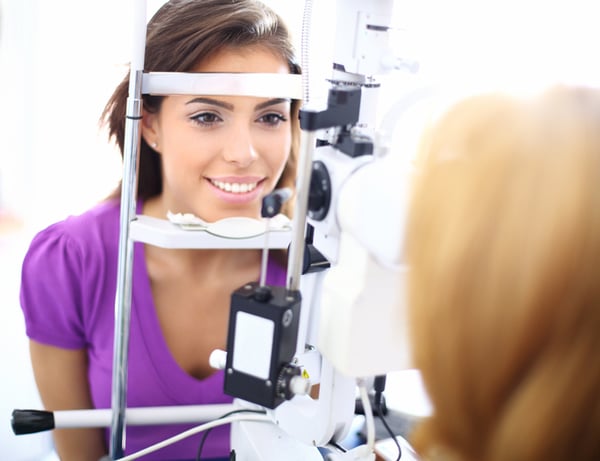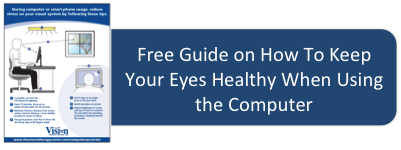
The National Eye Institute (NEI) has declared that May is Healthy Vision Month. Like many of these special months, the point is not to strive for healthy vision only during the month of May, but on an annual basis. That’s why the NEI offers up five smart ideas to keep your eyes healthy all year long - and we’ve added an extra bonus tip to help avoid Computer Vision Syndrome!
1. Get an eye health exam. We perform Functional Vision Exams at The Vision Therapy Center, and one component of those exams is to assess eye health. The eye health component includes checking eye pressure, pupil responses and internal and external structures including the lens, retina and optic nerve. Sight-threatening diseases such as glaucoma, macular degeneration and diabetic retinopathy can be ruled out or detected as part of this assessment.
2. Live a healthy lifestyle. Being overweight, smoking, and fostering bad eating habits can all contribute to poor eye health. The NEI offers up some examples of how an unhealthy lifestyle can affect your vision:
- Being overweight increases your risk of developing diabetes and other conditions which can lead to vision loss, such as diabetic eye disease or glaucoma.
- Smoking can lead to an increased risk of age-related macular degeneration, cataracts, and optic nerve damage.
- Chronic conditions, such as diabetes, hypertension and multiple sclerosis can result in damage to eye structure and even blindness.
3. Understand your family history. Many eye diseases are hereditary, including glaucoma and macular degeneration. Find out if you’ve had any eye diseases in your family, and be sure to inform your physician regarding your history.
4. Put on the protective eyewear. According to the NEI, every day about 2,000 US workers have a job-related eye injury that requires medical attention. Using the right eye wear can help you avoid those kinds of accidents. The eyewear can include:
- Safety glasses
- Goggles
- Safety shields
- Eye Guards
5. Be cool and healthy: Wear sunglasses. Not only do sunglasses evoke coolness, they can also help ward off the sun’s ultraviolet (UV) rays. The sun can inflict some serious damages on your eyes, including:
- Cataracts: The clouding of the eye’s lens can blur your vision, and an estimated 20% of cases are caused by extended UV exposure.
- Macular degeneration: Macular degeneration is likely the result of free radical damage, and UV exposure can accelerate that damage.
- Pterygium: UV light may contribute to this condition, which is a tissue growth over the white part of the eye that can, in some cases, affect the cornea.
6. Practice good computer visual habits. We’re going to add this one to the NEI’s list, because we are encountering an increasing number of functional vision problems as a result of poor visual habits at the computer screen.
We’ve detailed this in a previous post on the increasing number of computer programmers in Bangalore experiencing functional vision problems, specifically computer vision syndrome. These symptoms include minor eyestrain, redness of the eye, dry eye, and sleep disturbances.
As we’ve noted, the key to avoiding those issues is to practice good visual habits. Some of the top recommendations we’ve included in our flyer on avoiding Computer Vision Syndrome include:
- Don’t lie down on the job. Avoid viewing computer screens, iPads or smartphones while you’re lying down. Good posture is important; you’ll want to sit up.
- Assume the position. You should sit on a chair with your feet flat on the floor, and your legs at a ninety-degree angle.
- Look away. Every fifteen minutes, focus on an object at least 20 feet away for 20 seconds.
Be sure to download our worksheet full of helpful tips on how to avoid computer vision syndrome.
In the meantime, and in the months to come, be sure to make Healthy Vision Month a year-round event!

